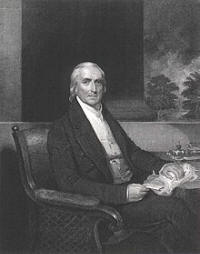Philip Syng Physick
(July
7, 1768 – December 15, 1837)
 Physick
graduated from the University of Pennsylvania in 1785, then began
the study of medicine under Dr. Adam Kuhn, and continued it in
London under Dr. John Hunter, becoming, on January 1, 1790, house
surgeon of St. George's hospital. In 1791 he received his license
from the Royal College of Surgeons in London, and was invited by Dr.
Hunter to assist him in his professional practice, but after a few
months went to the University of Edinburgh, where he received his
degree in medicine in 1792. Physick
graduated from the University of Pennsylvania in 1785, then began
the study of medicine under Dr. Adam Kuhn, and continued it in
London under Dr. John Hunter, becoming, on January 1, 1790, house
surgeon of St. George's hospital. In 1791 he received his license
from the Royal College of Surgeons in London, and was invited by Dr.
Hunter to assist him in his professional practice, but after a few
months went to the University of Edinburgh, where he received his
degree in medicine in 1792.
He returned to Philadelphia to practice, taking a position at
Pennsylvania Hospital. One of the foremost surgeons of the time, Dr.
Physick was among the few doctors who remained in the city to care
for the sick during Philadelphia's decimating yellow fever epidemic
of 1793. His many patients included John Adams's daughter, Dolley
Madison, Chief Justice John Marshall (from whom he removed almost
1,000 bladder stones, effecting a complete cure), and Dr. Benjamin
Rush. When President Andrew Jackson consulted with Dr. Physick about
his lung hemorrhages, he was told to stop smoking.
Dr. Physick pioneered the use of the stomach pump, used autopsy as a
regular means of observation and discovery, excelled in cataract
surgery, and was responsible for the design of a number of surgical
instruments, such as the needle forceps, the guillotine/snare for
performing tonsillectomies, and improved splints and traction
devices for treatment of dislocations; he also innovated many
operative techniques. Dr. Physick was one of the most sought-after
medical lecturers of the 19th century. His lectures prepared a
generation of surgeons for service throughout America. It is because
of his status as a teacher that he was dubbed the "Father of
American Surgery."[citation needed].
Physick died in Philadelphia and was interred at Christ Church
Burial Ground
|
|